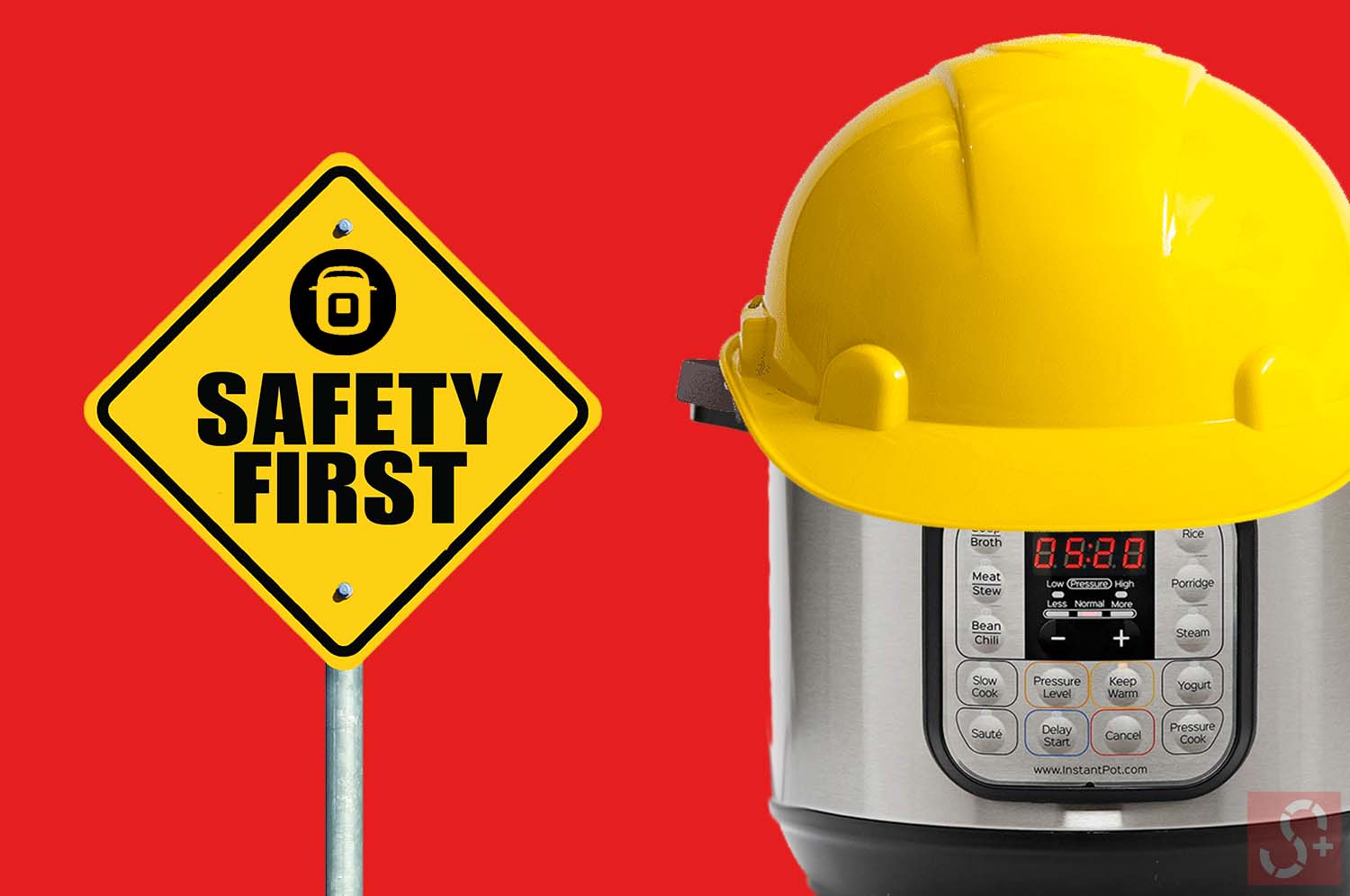The Instant Pot has seen nationwide success! It has become America’s number one multi cooking device.
Like any other mechanical device, there’s a safe way and not so safe way to handle it. Many people believe that the Instant Pot is an entirely hands-off device once it’s set.
Some might say, “it’s simply set and forget it type of device.” As convenient as the Instant Pot is, it should always be attended to and handled with care.
I, too, believed that it was a set it and forget type of device. Till one day, it occurred to me that this device holds an immense amount of built-up pressure, which can cause injury if not handled with care.
I started doing extensive research on how to operate an Instant Pot and the best safety practices. I took all the information I learned and combined it into this easy to digest article.
I love the Instant Pot, and in no way shape or form, I would ever discredit this fantastic simple, time-saving device! I just want to make sure people are well informed and enjoy their Instant Pot for years to come!
It’s not an accident why it’s one of the top-selling kitchen appliances in the market today.
To me, using an Instant Pot is like driving a vehicle. The benefit of driving is getting to where you need to go. But vehicles can be hazardous if not handled properly.
The Instant Pot comes with many safety mechanisms. But, be sure not to take them for granted. You still have to do your part to ensure its safety in your home.
Below is a full list of safety tips to reduce the risk of injury when operating an Instant Pot.
Don’t leave your Instant Pot completely unattended
The Instant Pot is an all in one self-contained device.
It’s pretty much hands-free once it set. The desire to leave it unattended for long periods is high.
It comes with several safety mechanisms, but you should still exercise the best safety practices.
You should be close enough to intervene just in case your instant pot malfunctions!
Many people don’t like reading manuals, so I’ll break down some of the most important things to know about Instant Pot safety in this article. I still do recommend reading the manual, primarily how to operate your Instant Pot.
You’ll want to be around if the Instant Pot gives you warning signs, such as “Burn.”
And never leave your home when it is cooking with pressure.
It’s not meant for deep frying
Yes, the Instant Pot is a multi-cooker and can do many things. But, deep frying is NOT one of those things.
Although professional kitchens use a commercial pressure fryer to make fried chicken, the pressure applied is very low, it is in the range of 5 psi, whereas the Instant Pot ranges from 10 – 11.6 psi. Hence, the Instant Pot is not designed for pressure frying!
It is very dangerous to do any deep frying in your Instant Pot. Not only for the pot itself but also for anyone around it.
The closes thing to frying you can do with an Instant Pot multi-cooker is Air frying. Keep in mind with an air fryer, you will not get the same taste and texture as deep frying.
But it is still an excellent option to have combined with all the other cooking options you can do with an Instant Pot.
The Instant Pot has two options for air frying. You can get an air fryer lid addon for your multifunction pot, or you can use the stand-alone air fryer.
Pay attention to how full your pot gets
Although there is a max fill line written inside of your inner pot, it is still possible that you are overfilling it.
A good rule to follow is only to fill the pot 2/3 full when cooking at high pressure and use cooking settings with foods that do not expand.
Fill the pot only 1/2 full when cooking at high pressure with ingredients that expand, such as rice, pasta, beans, oatmeal, and dried vegetables.
Check and maintain silicone sealing ring
The sealing ring is one of the essential parts of your Instant Pot. It seals your Instant Pot tightly and is necessary for high-pressure cooking. It is a critical safety feature.
When putting the sealing ring back onto the lid, make sure it is installed correctly. Installing the sealing ring consists of pushing it firmly around the inner edge of the Instant Pot lid. Make sure the sealing ring is in place and sitting consistently right around your lid.
Make sure to give your silicone ring a visual inspection regularly. Make sure it is torn, warp, and crack-free. If you spot any issues, replace them immediately!
Silicone rings are inexpensive, and it’s not worth your personal safety to try to prolong the life of a damaged silicone ring.
It would be best if you were to replace your silicone ring every 18 to 24 months. The best idea is to have one extra at home, ready for replacing when needed.
Use enough liquid in your Instant Pot
A minimum of 1 cup of liquid is required to use your Instant Pot when cooking at high pressure to create and maintain its pressure.
For example, you can use water, vegetable stock, chicken stock, meat juice, or cooking wine, etc.
Stay away from the steam the Instant Pot puts out
The steam coming out of your freshly made dish is super hot, so you want to keep your face and hands away from it because it can cause injury.
When you open your lid, do so facing it away from your face and use gloves when you’re ready to remove your inner pot.
If you are going to “quick release” the pressure, be cautious and careful that it is away from your face, and also use protective gloves when doing so.
Don’t force open the Instant Pot lid
Always make sure that you close the lid properly on your Instant Pot. Follow the diagram on the pot to securely seal it, before turning on any preset buttons.
Once your lid is sealed, under no circumstance should you ever force the Instant Pot lid open! If it is locked, that means that the pressure is still high, and it is unsafe to open.
Only open the lid when it easily turns.
Once again, do not try to force open the lid before all the pressure is released!
Carry your Instant Pot properly
When moving your Instant Pot from one location to another, make sure to use both your hands to hold onto the side handles of the Instant Pot.
Do not ever lift or carry your Instant Pot from the top lid handle. That is only used to open and close your lid.
Keeping Instant Pot clean
Dry the surfaces before closing the lid.
It would be best if you also washed your silicone ring after each use to remove any food smell and any leftover food particles.
Leaving remnants of food on your silicone ring can break down the material and increase the deterioration process.
Also, make sure that the silicone ring is dry before putting it back on the lid and closing your Instant Pot when putting it away.
Once in a while its good to wash your silicone lid in the dishwasher on high heat, if possible. And you can also soak it in white vinegar to disinfect.
If you see any mold on your silicone lid, make sure to replace it immediately. A word of advice, make sure to purchase it from Instant Pot to be on the safe side, rather than a third party company.
Check to make sure that the anti-block shield doesn’t have any food residue stuck in it.
How to clean your instant pot: 13 easy steps to keep your pot in tip-top condition
Itemized safety tips to consider
- Check for cracks in sealing ring
- Sealing ring properly inserted on the lid
- The sealing ring has been replaced within 1.5-2 years
- No food residue on the anti-block shield
- Lid properly closed
- Enough liquid in the pot (at least 1 cup)
- Filled only to 1/2 of the pot (expanding food) or 2/3 of the pot (non-expanding food)
- Smart preset selected with the right less-normal-more mode
My Final Thoughts
We live in a world of convenient tools that help us save time and also improves our life. We must always keep in mind the very same things that are so helpful can also be detrimental to our health. It’s our responsibility to make sure we use these tools properly. It’s always a good idea to refer to the manufactures documentation.
REVIEW WHAT YOU HAVE READ
Checkmark the items you have learned. If you need to review it again click on the words to bring you back to that section.








